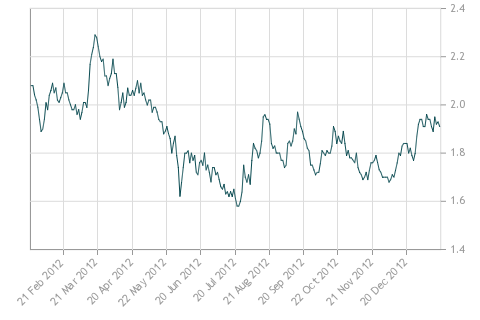Following up from my previous post on Holloway Lodging’s (TSX: HLR.UN) debt situation, I notice on December 22, 2011 they gave a conversion notice of their debentures to units:
Holloway Lodging Real Estate Investment Trust (TSX: HLR.UN HLR.DB.A) (“Holloway” or the “REIT”) announces that it has today given notice to the holders (the “Debentureholders”) of its 6.5% convertible unsecured subordinated debentures (the “Debentures”) that it will redeem the Debentures in full on January 23, 2012 and that it will satisfy the redemption price of the Debentures on the redemption date by issuing trust units (“Units”) of the REIT in lieu of cash, in accordance with the terms of the trust indenture for the Debentures (the “Indenture”). Any accrued and unpaid interest on the Debentures will be paid in cash on the redemption date.
…
The number of Units to be issued to Debentureholders will be determined by dividing the aggregate principal amount of Debentures outstanding by 95% of the weighted average trading price per Unit for the 20 consecutive trading days ending on the fifth trading day preceding the redemption date (the “Current Market Price”). Based on the redemption date of January 23, 2012, the 20-trading day period commenced on and included December 15, 2011 and will end on and include January 16, 2012.
…
Holloway also announces that it will not make the interest payment on its Debentures when such payment is due on December 31, 2011. Holloway intends to make such payment by January 13, 2012, as permitted by the terms of the Indenture.
This is a significant development for unitholders in that the roughly $51.8M face value of debentures outstanding (at least as reported by the TSX; this may be slightly lower due to buybacks) will be converted at the rate of approximately 7-8 cents per share, at least given existing trading patterns to date. Unit prices cratered from 20 cents to as low as 4 cents upon the announcement (currently trading at 10 cents), while debenture prices dropped from 58 cents to as low as 40 cents and is currently at 53 cents on the dollar.
Assuming an 8 cent per unit conversion price, this would mean dilution of about 94% for existing unitholders. Somebody holding $1,000 face value of debentures would receive 12,500 units, implying a unit price of about 4.25 cents post-conversion. The remaining entity will have about 670 million units outstanding and at 4.25 cents per unit it would imply a market capitalization of about 28 million.
Using the 2010 cash flow statement as a very blunt proxy for future performance, the entity without the convertible debentures will be able to pull in about $5.9 million in operating cash flow, which would put it on sounder financial footing. It could suggest that the post-conversion trading price of the units will be around 7-8 cents.
Finally, the company has decided to consolidate the remainder of its non-mortgage debt on the chairman’s company Geosam:
Holloway also announces that it has entered into a second amendment to its credit agreement dated as of June 15, 2011 among Holloway, Geosam Capital Inc. (“Geosam”), as administrative agent, and Geosam, together with such other persons from time to time party to the credit agreement, as lenders, (the “Credit Agreement”) to increase the amount of funds available for drawdown by $3.6mn for certain limited purposes. Holloway has increased the amount outstanding under the Credit Agreement by $1.8mn in order to purchase from the holders of its interest-bearing promissory notes approximately $2.8mn of such notes, representing all of Holloway’s interest-bearing promissory notes outstanding.
This is presumably linked to the resignation of the CEO (Squires) that lasted in the company longer than I expected him to after the takeover of the company by George Aryoman and Geosam.
My conclusion here is that the market is valuing the debentures and units as slightly expensive, but it is within an order of magnitude of a fair valuation. Finally, my continuing thesis is that the only entity that will make any money from Holloway will be Aryoman and Geosam by virtue of their control of the company and the secured credit facility which will continue to hive off interest income from Holloway unitholders. This will continue as the assets are stripped and sold from the trust.
In other words, this is a fun one to watch, but not to invest in. I feel fortunate to dump my debentures at the price that I got for them (roughly 60-65 cents) and get out of dodge. If unit prices go down to the 4 cent level again, the trust may be worth putting a few pennies in, but this would be one of those typical “pick up the cigar butt off the street for one last puff” type value plays.

